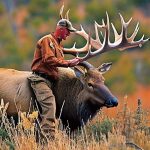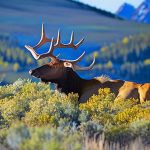Your cart is currently empty!

Mastering the Art of Archery Elk Hunting: Tips and Tricks for a Successful Hunt

Elk hunting with a bow and arrow is a challenging and rewarding experience that requires a deep understanding of elk behavior and habitat. Unlike hunting with a rifle, archery hunting requires hunters to get up close and personal with their prey, relying on stealth, accuracy, and precision. In order to be successful in this pursuit, it is crucial to have a comprehensive knowledge of elk behavior, their preferred habitat, and the equipment and techniques necessary for a successful hunt.
Understanding elk behavior and habitat is essential for any bowhunter. Elk are social animals that live in herds, typically consisting of cows, calves, and a dominant bull. They have a complex social structure and communicate through various vocalizations and body language. By understanding their behavior, hunters can anticipate their movements and increase their chances of a successful hunt.
Elk prefer habitats that provide them with ample food sources, cover, and water. They are primarily found in mountainous regions with dense forests, meadows, and open grasslands. They are herbivores and feed on a variety of plants, including grasses, shrubs, and tree bark. By understanding their preferred food sources and habitat, hunters can narrow down potential hunting locations and increase their chances of encountering elk.
Key Takeaways
- Elk behavior and habitat are important factors to consider when planning a hunt.
- Choosing the right equipment, including bows, arrows, and accessories, is crucial for success.
- Mastering archery techniques such as accuracy and precision can improve your chances of a successful hunt.
- Planning your hunt based on timing, location, and weather can increase your chances of finding elk.
- Scouting for elk using tracks, sign, and trail cameras can help you locate them more easily.
Understanding the Elk: Behavior and Habitat
Elk behavior is influenced by their social structure. Bulls compete for dominance during the rutting season, which occurs in the fall. During this time, they emit bugling calls to attract cows and establish their dominance over other bulls. Cows give birth to calves in the spring and form maternal groups to protect them from predators.
Elk prefer habitats that provide them with ample food sources, cover, and water. They are primarily found in mountainous regions with dense forests, meadows, and open grasslands. They are herbivores and feed on a variety of plants, including grasses, shrubs, and tree bark. By understanding their preferred food sources and habitat, hunters can narrow down potential hunting locations and increase their chances of encountering elk.
Choosing the Right Equipment: Bows, Arrows, and Accessories
Choosing the right equipment is crucial for a successful elk hunt. When it comes to bows, there are several options to consider, including compound bows, recurve bows, and longbows. Compound bows are the most popular choice among bowhunters due to their power and accuracy. Recurve bows and longbows are also effective but require more skill to use effectively.
Arrows should be chosen based on their weight, spine, and broadhead compatibility. It is important to select arrows that are appropriate for the draw weight of your bow and the type of broadheads you plan to use. Carbon arrows are a popular choice due to their durability and accuracy.
In addition to bows and arrows, there are several accessories that can enhance your elk hunting experience. A good quality bow sight can improve accuracy, while a stabilizer can help reduce bow vibration. A release aid can also improve accuracy by providing a consistent release.
Mastering Archery Techniques: Accuracy and Precision
| Technique | Accuracy Score | Precision Score |
|---|---|---|
| Stance | 8.5 | 9.0 |
| Grip | 9.0 | 8.5 |
| Aim | 9.5 | 9.0 |
| Release | 9.0 | 9.5 |
| Follow-through | 8.0 | 8.5 |
Accuracy and precision are crucial in elk hunting with a bow and arrow. Unlike hunting with a rifle, archery hunting requires hunters to get up close and personal with their prey, often within 40 yards or less. This means that every shot must be precise in order to ensure a clean kill.
There are several tips and techniques that can help improve archery skills. Practicing regularly is essential for developing muscle memory and improving accuracy. It is also important to practice shooting from various positions, including standing, kneeling, and sitting.
Another important aspect of archery hunting is understanding shot placement. The vital organs of an elk are located in the chest cavity, so it is important to aim for this area when taking a shot. The ideal shot placement is behind the shoulder, aiming for the heart and lungs.
Planning Your Hunt: Timing, Location, and Weather
Timing, location, and weather are all important factors to consider when planning an elk hunt. The best times of year to hunt elk are during the rutting season in the fall and during the early morning and late evening hours when elk are most active.
Choosing the right location is also crucial for a successful hunt. Elk prefer habitats with ample food sources, cover, and water. It is important to research potential hunting locations and scout them beforehand to ensure that they meet these criteria.
Weather conditions can also impact elk behavior and movement. Elk are more active during cooler temperatures, so hunting during early morning or late evening hours when temperatures are lower can increase your chances of encountering elk. It is also important to pay attention to wind direction, as elk have a keen sense of smell and can easily detect human scent.
Scouting for Elk: Tracks, Sign, and Trail Cameras

Scouting for elk is an important part of the hunting process. By identifying elk tracks and sign, hunters can determine where elk are feeding, bedding, and traveling. Elk tracks are typically larger than deer tracks and have a distinct shape with a rounded front and pointed rear.
In addition to tracks, there are several other signs that can indicate the presence of elk. Rubs on trees, where elk have rubbed their antlers to remove velvet or mark their territory, are a common sign. Scrapes, where elk have pawed at the ground to mark their territory or communicate with other elk, are also a good indicator of elk activity.
Trail cameras can also be a valuable tool for scouting elk. These cameras can be set up in areas where elk are likely to pass by and can provide valuable information about their movement patterns and behavior. By reviewing trail camera footage, hunters can determine the best locations to set up their stands or blinds.
Setting Up a Successful Elk Stand: Camouflage and Concealment
Setting up an effective elk stand is crucial for a successful hunt. Elk have keen senses and can easily detect movement and human scent. It is important to choose a location that provides good visibility and cover, while also being downwind of where you expect elk to approach.
Camouflage and concealment are also important factors to consider when setting up an elk stand. It is important to blend in with your surroundings and avoid wearing bright colors or patterns that can easily be spotted by elk. Using natural cover, such as trees or brush, can also help break up your silhouette and make you less visible to elk.
Calling Elk: Types of Calls and Strategies
Calling elk is a popular technique used by bowhunters to attract elk within range. There are several types of elk calls that can be used, including bugles, cow calls, and calf calls. Bugles are typically used by hunters to imitate the sound of a dominant bull and attract other bulls or cows. Cow calls are used to imitate the sound of a cow in estrus, while calf calls are used to imitate the sound of a lost or distressed calf.
When calling elk, it is important to use realistic and convincing calls. Elk have keen hearing and can easily detect unnatural or poorly executed calls. It is also important to use calls sparingly and strategically, as overcalling can alert elk to your presence.
Tracking and Stalking Elk: Stealth and Patience
Tracking and stalking elk requires a combination of stealth and patience. Elk have keen senses and can easily detect movement, sound, and human scent. It is important to move slowly and quietly when tracking or stalking elk, taking care to avoid stepping on twigs or breaking branches.
Patience is also key when tracking or stalking elk. It may take hours or even days to locate a suitable target, and it is important to remain patient and persistent. It is also important to be aware of wind direction and use it to your advantage, as elk have a keen sense of smell and can easily detect human scent.
Field Dressing and Processing Elk: Techniques and Tools
Field dressing and processing an elk is an important step in the hunting process. Field dressing involves removing the internal organs of the animal to prevent spoilage and make it easier to transport. This should be done as soon as possible after the kill to ensure the meat stays fresh.
There are several techniques for field dressing an elk, but the most common method involves making a shallow incision from the sternum to the pelvis and removing the internal organs. It is important to be careful not to puncture the stomach or intestines, as this can contaminate the meat.
Once the elk has been field dressed, it can be processed into various cuts of meat. This can be done at home or by a professional butcher. It is important to have the necessary tools for processing elk meat, including a sharp knife, cutting board, and meat grinder or slicer.
Safety and Ethics in Archery Elk Hunting: Rules and Regulations
Safety should always be a top priority when hunting elk with a bow and arrow. It is important to follow all rules and regulations set forth by the state wildlife agency, including obtaining the necessary licenses and permits. It is also important to practice safe shooting techniques and always be aware of your surroundings.
Ethics are also an important consideration when hunting elk with a bow and arrow. It is important to hunt responsibly and ethically, ensuring that animals are killed quickly and humanely. It is also important to respect private property rights and obtain permission from landowners before hunting on their property.
Elk hunting with a bow and arrow is a challenging and rewarding experience that requires a deep understanding of elk behavior and habitat. By understanding elk behavior and habitat, choosing the right equipment, mastering archery techniques, planning your hunt, scouting for elk, setting up an effective elk stand, calling elk, tracking and stalking elk, field dressing and processing elk, and following safety and ethical guidelines, you can increase your chances of a successful hunt. So grab your bow and arrow and give elk hunting a try – you won’t be disappointed!
If you’re an avid archery elk hunter, you might be interested in this article on the Old Oak Syndicate website that provides valuable tips and insights on the best time of year to hunt rabbits. Hunting rabbits can be a thrilling and challenging experience, and knowing when they are most active can greatly increase your chances of success. Check out the article here to learn more about the optimal time to pursue these elusive creatures in the wild. Happy hunting!
FAQs
What is archery elk hunting?
Archery elk hunting is a type of hunting where hunters use a bow and arrow to hunt elk.
When is the archery elk hunting season?
The archery elk hunting season varies by state, but it typically runs from August to September.
What equipment do I need for archery elk hunting?
You will need a bow, arrows, broadheads, a quiver, a release aid, a backpack, binoculars, a rangefinder, and appropriate clothing and footwear.
Do I need a license to go archery elk hunting?
Yes, you will need a hunting license and a tag specific to elk hunting. These can be obtained from your state’s wildlife agency.
Where can I go archery elk hunting?
Elk can be found in many western states, including Colorado, Montana, Wyoming, and Idaho. You will need to research the specific regulations and hunting areas for each state.
Is archery elk hunting dangerous?
As with any type of hunting, there are risks involved. It is important to follow all safety guidelines and regulations, and to be aware of your surroundings at all times.
What is the success rate for archery elk hunting?
The success rate for archery elk hunting varies depending on the hunter’s skill level, the hunting area, and other factors. It is important to have realistic expectations and to enjoy the experience regardless of the outcome.

Herb has been a longtime lover of the outdoors. Whether it be hunting, camping, fishing or just getting outside to reset. Proud father and animal lover. Bourbon anyone?

by
Tags:
Comments

Categories
- Big Game Hunting (301)
- Deer (202)
- Reviews (3)
- Shooting (16)
- Slingshot (1)
- Small Game Hunting (42)
- Upland Hunting (126)
- Waterfowl Hunting (3)





Leave a Reply